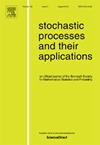朗格万蒙特卡罗的并行中点随机化
IF 1.2
2区 数学
Q3 STATISTICS & PROBABILITY
引用次数: 0
摘要
在对数密度梯度并行计算可行的框架中,研究了从目标概率密度函数中抽样的问题。关注光滑和强对数凹密度,我们重新审视并行随机中点方法,并使用最近开发的技术来分析其顺序版本,研究其性质。通过这些技术,我们得到了采样密度和目标密度之间的Wasserstein距离的上界。这些界限量化了通过并行处理实现的大量运行时改进。本文章由计算机程序翻译,如有差异,请以英文原文为准。
Parallelized midpoint randomization for Langevin Monte Carlo
We study the problem of sampling from a target probability density function in frameworks where parallel evaluations of the log-density gradient are feasible. Focusing on smooth and strongly log-concave densities, we revisit the parallelized randomized midpoint method and investigate its properties using recently developed techniques for analyzing its sequential version. Through these techniques, we derive upper bounds on the Wasserstein distance between sampling and target densities. These bounds quantify the substantial runtime improvements achieved through parallel processing.
求助全文
通过发布文献求助,成功后即可免费获取论文全文。
去求助
来源期刊

Stochastic Processes and their Applications
数学-统计学与概率论
CiteScore
2.90
自引率
7.10%
发文量
180
审稿时长
23.6 weeks
期刊介绍:
Stochastic Processes and their Applications publishes papers on the theory and applications of stochastic processes. It is concerned with concepts and techniques, and is oriented towards a broad spectrum of mathematical, scientific and engineering interests.
Characterization, structural properties, inference and control of stochastic processes are covered. The journal is exacting and scholarly in its standards. Every effort is made to promote innovation, vitality, and communication between disciplines. All papers are refereed.
 求助内容:
求助内容: 应助结果提醒方式:
应助结果提醒方式:


